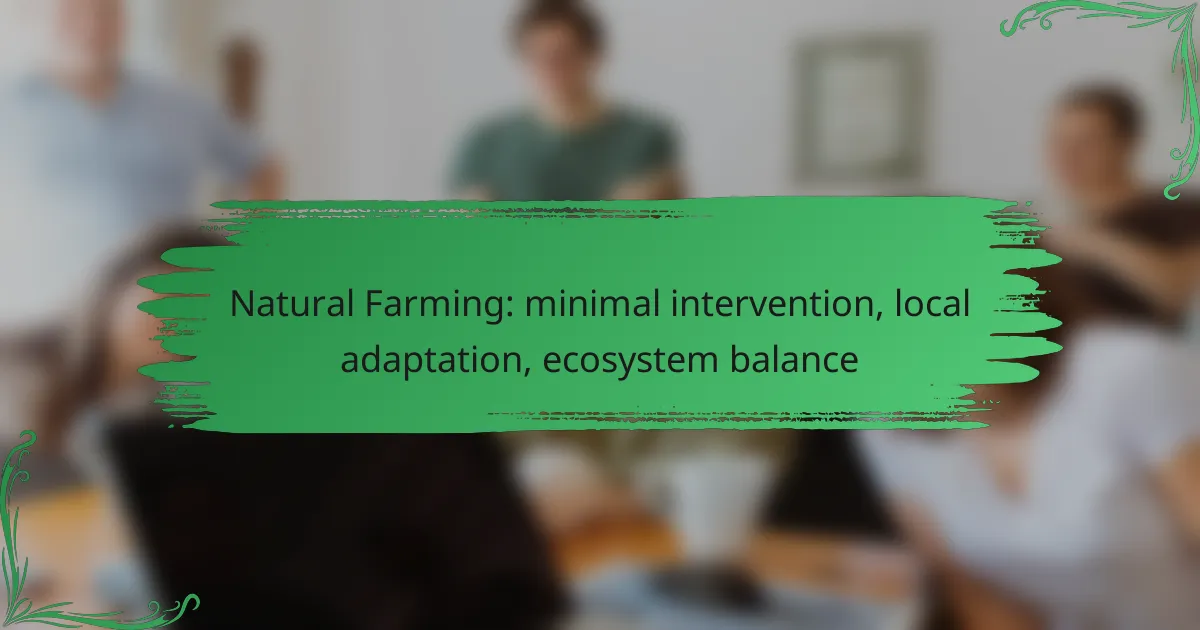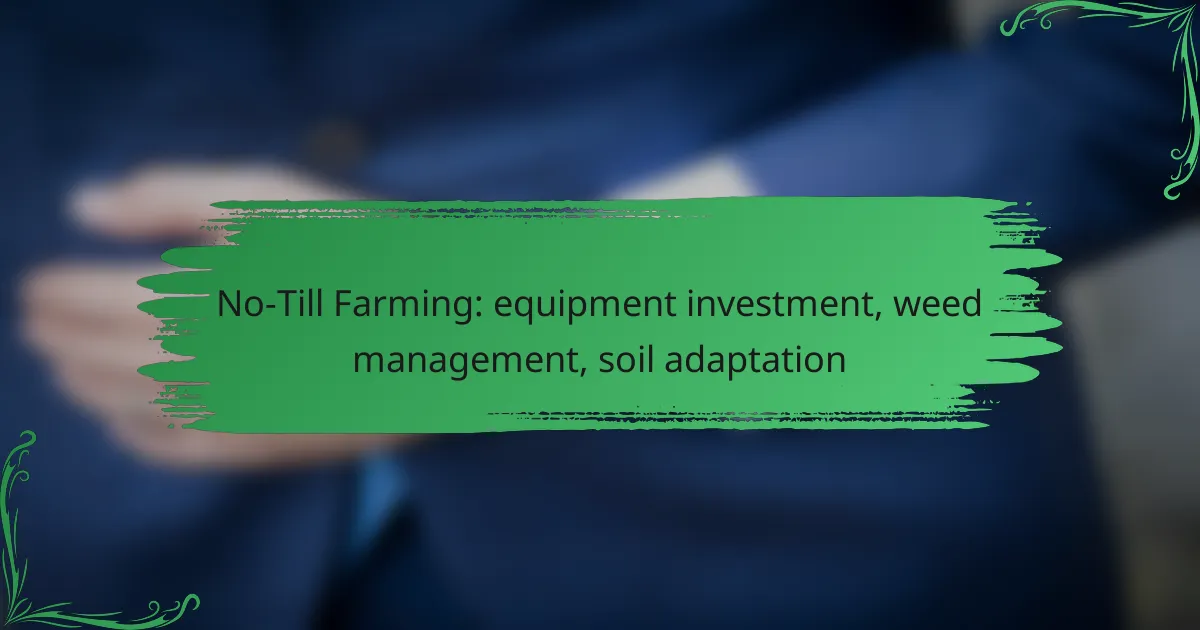Natural farming is an innovative agricultural approach that emphasizes minimal human intervention and promotes ecosystem balance. By fostering local adaptation and utilizing practices such as cover cropping and composting, it creates a self-sustaining environment that enhances soil health and supports resilient crops. This method not only reduces resource use but also encourages harmonious interactions among plants, animals, and microorganisms, leading to healthier ecosystems.

How does natural farming promote ecosystem balance?
Natural farming promotes ecosystem balance by minimizing human intervention and allowing natural processes to thrive. This approach fosters a self-sustaining environment where plants, animals, and microorganisms interact harmoniously, leading to healthier ecosystems.
Minimizes chemical inputs
Natural farming significantly reduces or eliminates the use of synthetic fertilizers and pesticides. By relying on organic materials such as compost and natural pest control methods, farmers can maintain crop health without harming surrounding ecosystems.
This reduction in chemical inputs not only protects beneficial insects and soil organisms but also decreases the risk of water contamination. Farmers can adopt practices like crop rotation and intercropping to naturally enhance soil fertility and pest resistance.
Enhances biodiversity
Natural farming practices encourage a diverse range of plant and animal species, which contributes to a balanced ecosystem. By planting a variety of crops and maintaining natural habitats, farmers can support pollinators and other wildlife essential for ecosystem health.
Increased biodiversity helps create resilience against pests and diseases, reducing the need for chemical interventions. Farmers can implement strategies such as agroforestry or permaculture to further enhance biodiversity on their farms.
Improves soil health
Healthy soil is a cornerstone of natural farming, as it supports plant growth and ecosystem balance. Practices such as cover cropping, reduced tillage, and organic amendments improve soil structure, fertility, and microbial activity.
Maintaining soil health can lead to increased water retention and reduced erosion, benefiting both crops and the surrounding environment. Farmers should regularly assess soil health through simple tests and adjust their practices accordingly to ensure ongoing fertility and productivity.

What are the key practices in natural farming?
Natural farming emphasizes minimal intervention, local adaptation, and ecosystem balance through several key practices. These practices include cover cropping, crop rotation, and composting, each contributing to soil health and sustainable agricultural systems.
Cover cropping
Cover cropping involves planting specific crops during off-seasons to protect and enrich the soil. These crops, such as clover or rye, prevent erosion, suppress weeds, and enhance soil fertility through nitrogen fixation.
When selecting cover crops, consider local climate and soil conditions. Generally, planting cover crops in the fall and terminating them in the spring can significantly improve soil structure and nutrient availability.
Crop rotation
Crop rotation is the practice of alternating different crops in the same field over time to improve soil health and reduce pest and disease pressure. This method disrupts pest life cycles and enhances nutrient cycling by varying root structures and nutrient demands.
A common rotation might include legumes followed by cereals, allowing legumes to enrich the soil with nitrogen before planting nitrogen-demanding crops. Aim for a rotation plan that spans at least three to four years for optimal benefits.
Composting
Composting involves the decomposition of organic matter, such as kitchen scraps and yard waste, to create nutrient-rich soil amendments. This practice reduces waste and enhances soil fertility by returning essential nutrients to the earth.
To start composting, maintain a balanced mix of green materials (nitrogen-rich) and brown materials (carbon-rich). Regularly turning the compost pile can speed up decomposition, typically taking several months to a year to produce usable compost.

How can local adaptation improve farming outcomes?
Local adaptation enhances farming outcomes by aligning agricultural practices with the specific environmental and cultural conditions of a region. This approach leads to more resilient crops, reduced resource use, and improved ecosystem health.
Utilizes native plant species
Using native plant species is crucial for local adaptation as these plants are naturally suited to the local environment. They typically require less water and fertilizer, making them more sustainable choices for farmers.
For example, in Mediterranean climates, crops like olives and grapes thrive due to their natural adaptation to the region’s dry summers and wet winters. This reduces the need for irrigation and chemical inputs, benefiting both the farmer and the ecosystem.
Considers local climate conditions
Adapting farming practices to local climate conditions involves understanding rainfall patterns, temperature ranges, and seasonal variations. Farmers can select crop varieties that are more resilient to local weather extremes, such as drought-resistant grains in arid regions.
For instance, in areas with high humidity, farmers might choose crops that are less susceptible to fungal diseases, thereby minimizing pesticide use. This tailored approach can lead to higher yields and lower production costs.
Incorporates traditional knowledge
Incorporating traditional knowledge is essential for local adaptation, as it encompasses centuries of experience in managing local ecosystems. Farmers can benefit from practices such as crop rotation, intercropping, and soil management techniques that have been refined over generations.
For example, indigenous practices in the Andes involve planting potatoes at different altitudes to take advantage of varying microclimates. This not only maximizes yield but also preserves biodiversity and soil health, demonstrating the value of traditional agricultural wisdom.

What are the benefits of minimal intervention in agriculture?
Minimal intervention in agriculture offers significant advantages, including reduced costs and improved ecosystem health. By limiting human interference, farmers can enhance natural processes that promote sustainability and resilience.
Reduces labor costs
Minimal intervention farming often leads to lower labor costs, as it requires less manual work and fewer inputs. Farmers can save on expenses related to tilling, chemical applications, and extensive monitoring.
For instance, practices like cover cropping and mulching can suppress weeds naturally, reducing the need for labor-intensive weeding. This approach allows farmers to allocate resources more efficiently and focus on other critical tasks.
Increases resilience to pests
By fostering a balanced ecosystem, minimal intervention can enhance a farm’s resilience to pests. Natural predators, such as birds and beneficial insects, thrive in environments with less chemical disruption, effectively controlling pest populations.
Farmers can implement strategies like crop rotation and intercropping to diversify plant species, which can confuse pests and reduce their impact. This ecological approach often leads to healthier crops and a more stable yield over time.
Enhances crop quality
Minimal intervention practices can improve the overall quality of crops by promoting healthier soil and reducing chemical residues. Healthier soil supports diverse microbial life, which in turn enhances nutrient availability for plants.
For example, organic matter from compost or cover crops can improve soil structure and fertility, leading to better-tasting and more nutritious produce. Consumers increasingly prefer high-quality, sustainably grown food, making this an attractive benefit for farmers.

How does natural farming compare to conventional farming?
Natural farming focuses on minimal intervention, local adaptation, and ecosystem balance, contrasting sharply with conventional farming practices that often rely on synthetic inputs and monoculture. This approach promotes biodiversity and sustainability, leading to healthier ecosystems and potentially more resilient agricultural systems.
Lower environmental impact
Natural farming significantly reduces environmental impact by minimizing chemical use and enhancing soil health. Practices such as crop rotation, cover cropping, and composting contribute to improved soil structure and fertility, which in turn reduces erosion and water pollution.
For example, a farm practicing natural methods may see a decrease in pesticide runoff, which can harm local waterways and wildlife. This approach not only benefits the environment but also aligns with growing consumer demand for eco-friendly products.
Higher sustainability
Natural farming promotes sustainability by fostering diverse ecosystems that can better withstand pests and diseases. By encouraging a variety of crops and natural pest control methods, farmers can reduce their reliance on external inputs, leading to a more self-sustaining agricultural system.
Farmers adopting these practices often find that their systems become more resilient over time, requiring less intervention and yielding more consistent results. This adaptability is crucial in the face of climate change and shifting market demands.
Long-term profitability
While initial yields in natural farming may be lower compared to conventional methods, the long-term profitability can be higher due to reduced input costs and increased resilience. By investing in soil health and biodiversity, farmers can create systems that are less vulnerable to market fluctuations and environmental stressors.
Additionally, consumers are increasingly willing to pay a premium for sustainably produced goods, which can enhance profitability for natural farmers. Establishing direct-to-consumer sales channels, such as farmers’ markets or community-supported agriculture (CSA), can further boost income while fostering community ties.

What are the challenges of implementing natural farming?
Implementing natural farming presents several challenges, including the need for extensive knowledge of local ecosystems and the potential for lower initial yields. Farmers must adapt their practices to align with natural processes, which can require significant changes in mindset and techniques.
Knowledge and Skill Requirements
Natural farming demands a deep understanding of local soil health, plant varieties, and pest management. Farmers need to be well-versed in ecological principles to make informed decisions about crop rotation, companion planting, and organic amendments. This may require training or mentorship, which can be a barrier for some.
Initial Yield Variability
When transitioning to natural farming, farmers often experience a dip in yields during the initial years. This variability can be discouraging, as traditional farming methods typically prioritize immediate productivity. Patience and a long-term perspective are essential, as ecosystems gradually stabilize and productivity improves.
Pest and Disease Management
Managing pests and diseases without synthetic chemicals can be challenging. Natural farming relies on biodiversity and natural predators to control pests, which may take time to establish. Farmers should consider integrating practices such as crop diversity and habitat creation to enhance ecosystem resilience against pests.
Market Acceptance and Economic Viability
Natural farming products may face hurdles in market acceptance, particularly in regions where conventional farming dominates. Farmers need to educate consumers about the benefits of natural farming and may need to establish direct sales channels to ensure fair prices. Understanding local market dynamics is crucial for economic sustainability.



